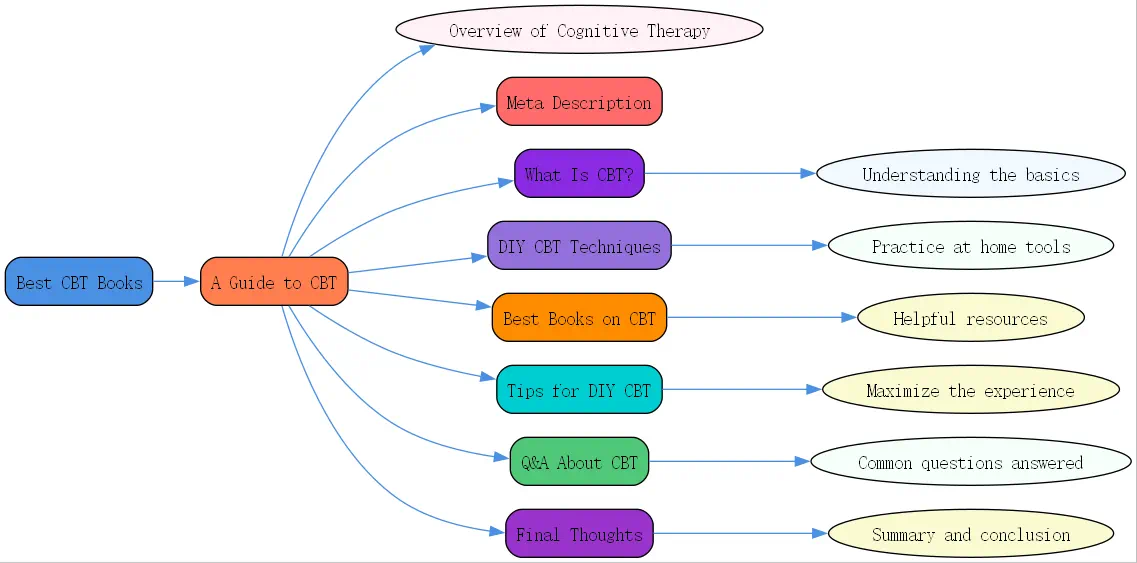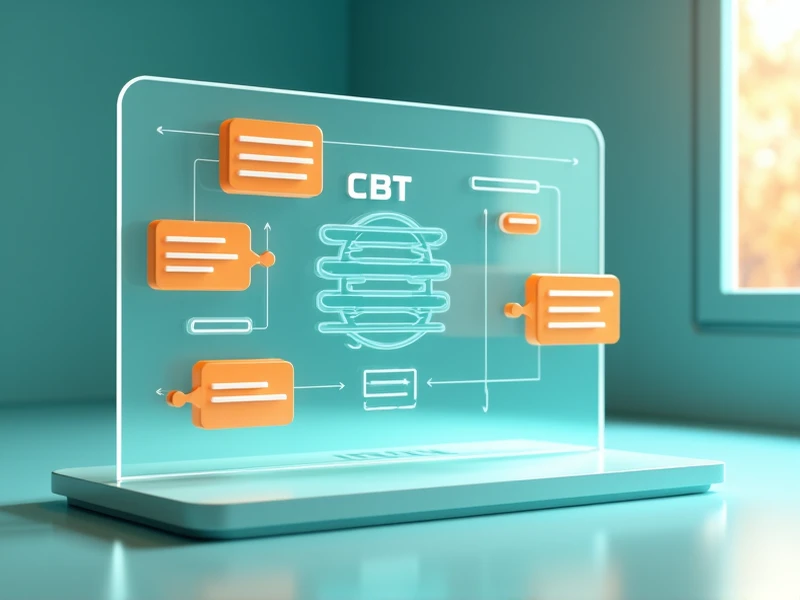Best CBT Books: A Guide to Cognitive Behavioral Therapy

Discover the best CBT books and techniques for improving mental health. Learn effective DIY cognitive behavioral therapy methods to challenge negative thoughts and foster well-being.
When it comes to enhancing mental health and building resilience against negative thoughts, Cognitive Behavioral Therapy (CBT) has emerged as one of the most effective tools available. Whether you’re embarking on a self-directed mental health journey or seeking actionable practices to complement therapy, understanding CBT’s core principles can make all the difference. In this guide, we’ll explore what CBT is, DIY techniques you can practice at home, and the best CBT books to deepen your knowledge and skills.
What Is Cognitive Behavioral Therapy (CBT)?
CBT is a type of evidence-based psychotherapy that helps individuals identify and transform negative thought patterns and behaviors. At its core, CBT is grounded in two foundational models:
1. Cognitive Model: Explains how individuals process information, emphasizing the influence of thoughts on emotions. 2. Behavioral Model: Focuses on how actions and behaviors impact mental well-being and emotions.
The key principle of CBT lies in understanding the intricate connection between thoughts, feelings, and behaviors. By identifying and challenging automatic negative thoughts, CBT provides actionable strategies to develop healthier coping mechanisms and improve overall well-being.
DIY CBT Techniques You Can Practice at Home
While CBT therapists provide invaluable guidance, there are several self-help techniques you can practice in the comfort of your own home. These practices aim to help you gain better control over anxious or intrusive thoughts, encouraging emotional balance and resilience.
1. Journaling for CBT: Tracking Thoughts and Emotions
Journaling is a simple yet powerful CBT tool that helps you track patterns in your thoughts and emotions. Writing down specific situations, emotional responses, and automatic thoughts allows you to observe recurring themes in your behavior.
Journaling Prompts for Self-Reflection:
- What happened today that made me feel anxious?
- How did my thoughts influence my actions in a specific situation?
- Are there recurring worries or fears that I experience?
To get started, dedicate 15–20 minutes daily to journaling. Over time, this practice not only reveals unproductive thought habits but also helps you replace them with constructive and balanced perspectives.
2. Creating Thought Records: Identifying Negative Thought Patterns
Thought records are a cornerstone of CBT. This technique involves dissecting specific situations where negative emotions arise and examining the thought processes driving those emotions.
Steps to Create an Effective Thought Record:
- Write down the event or situation that triggered strong emotions.
- Identify the specific emotions you felt during that moment.
- Document any automatic negative thoughts associated with those emotions.
- Identify the cognitive distortions, such as “all-or-nothing thinking” or catastrophizing.
- Challenge these thoughts with evidence and propose alternative perspectives.
- Reflect on any changes in your emotions after reframing the thoughts.
By practicing these steps regularly, you’ll notice patterns in your thinking that you can consciously redirect toward healthier outcomes.
3. Behavioral Experiments: Testing Your Beliefs in Real Life
Negative beliefs often govern our actions, leading to avoidance behaviors or unwarranted fears. Behavioral experiments help test these beliefs in controlled situations, equipping you with evidence to counter them.
For instance, if you feel certain that people will harshly judge you for making a mistake, conduct a simple experiment by purposefully making a minor error in public. The results often reveal that these fears are exaggerated. Implementing behavioral experiments can foster confidence and reduce anxiety, enhancing your everyday outlook.

4. Mindfulness and Relaxation Techniques: Enhancing CBT Benefits
Incorporating mindfulness practices into your daily routine can amplify the effects of CBT. Mindfulness emphasizes being present in the moment, while relaxation exercises ensure emotional regulation during stressful situations.
Suggested Mindfulness and Relaxation Techniques:
- Deep Breathing Exercises: Focus on slow, intentional breathing to lower stress levels.
- Progressive Muscle Relaxation: Tighten and release different muscle groups to relax your body.
- Guided Meditations: Use audio-guided sessions to center your thoughts.

Regular mindfulness practice not only reduces stress but also increases your self-awareness, helping you become more attuned to your thoughts and behaviors.
Best Books on CBT and Other Helpful Resources
If you’re looking to tailor these skills with additional insights and exercises, exploring the best books on CBT can be incredibly beneficial. These resources are invaluable for ongoing learning and skill development.
Recommended CBT Books and Workbooks
Here are two of the best books about CBT worth exploring: 1. Feeling Good by David D. Burns: Widely regarded as one of the best CBT books, this classic breaks down key CBT concepts and offers strategies to combat depression and improve emotional well-being. 2. The Anxiety and Worry Workbook by David A. Clark and Aaron T. Beck: Known for its actionable exercises, this workbook delivers step-by-step methods for challenging negative thoughts and reducing anxiety.
For a curated selection of resources specifically designed to help manage anxiety, check out our list of top books on anxiety management.
Online Resources for CBT
In addition to books, take advantage of digital tools designed to support your journey:
- Websites and Courses: Platforms like Mood Gym and CBT Nuggets offer interactive learning opportunities for mastering CBT strategies.
- Mobile Apps: Apps like Moodnotes and Pacifica allow you to track your thoughts, practice relaxation techniques, and incorporate CBT into daily life.
- Support Groups and Forums: Online communities provide a space to connect with others practicing CBT, offering valuable insights and encouragement.
These resources are especially useful for those balancing DIY efforts with professional support.
Tips for Making the Most of Your DIY CBT Experience
As with any self-help method, your success hinges on patience, consistency, and a positive mindset. Here are some practical tips to keep you on track:
Setting Realistic Expectations and Staying Consistent
- Understand that meaningful change takes time. It’s normal to feel discouraged initially, but persistence is key.
- Celebrate small victories, such as identifying and countering a single cognitive distortion. These moments signify progress and keep you motivated.
When to Seek Professional Help
While DIY CBT can be highly effective, it’s essential to recognize when professional support is needed. If you find yourself struggling to implement techniques or experiencing persistent challenges, seeking guidance from the best CBT therapist in your area can provide the extra support you need.
Maintaining Progress and Preventing Relapse
Preventing regression is just as important as initial progress. Here’s how you can maintain your gains:
- Regularly assess your thoughts, feelings, and behaviors to catch recurring patterns.
- Create a personalized coping plan for managing difficult situations.
- Build a strong support network of friends, family, or peers.
By staying proactive, you can sustain the positive outcomes of CBT over the long term.
Q&A: Frequently Asked Questions About CBT
Q: Can CBT be just as effective when practiced independently, without a therapist? A: While DIY CBT can provide remarkable benefits through journaling, thought records, and mindfulness exercises, professional therapy offers personalization and accountability. Combining both approaches can maximize results, especially when addressing complex mental health concerns.
Final Thoughts
At BrainTalking, we believe in empowering individuals to take charge of their mental health journeys. With the combination of self-directed CBT techniques, credible resources like the best CBT books, and professional support when needed, you can work toward improved well-being. Explore these methods, stay consistent, and celebrate your victories—no matter how small. Your mental health is worth the effort.
For a deep dive into anxiety-specific tools, visit our curated list of books on anxiety management. Whether you’re starting your CBT journey or enhancing it, the right support can make all the difference.





